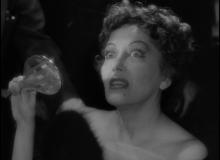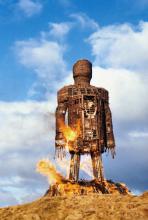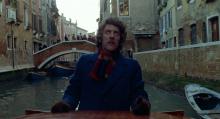This essay on Billy Wilder's Fedora was written by Cinematheque Programmer and Project Assistant Amanda McQueen. A new DCP restoration of Fedora will screen at the Cinematheque on Friday, November 14 at 7 p.m. in 4070 Vilas Hall.
By Amanda McQueen
In 2008, I spent a month in New York City chaperoning my little sister. Luckily, the summer dance program she was attending was located just down the street from the Walter Reade Theatre, so I spent my afternoons watching whatever films happened to be playing. The Film Society of Lincoln Center was doing a retrospective of William Holden at the time, and sandwiched between movies like Sunset Blvd. (1950), which I'd seen over and over, and movies like S.O.B. (1981), which I'd been wanting to see for ages, was this movie called Fedora, which I'd never heard of. They only had a beat up 16mm print, but even through the scratches and fading, Billy Wilder's penultimate film shone through and stuck with me.
Based on a novella by actor-turned-writer Thomas Tryon, Fedora has been seen as a companion piece to Sunset Blvd., albeit with some role reversals, a bit more autobiography, and a dose of Dorian Gray. Another of Wilder's films about Hollywood, Fedora tells of down-on-his-luck producer Barry "Dutch" Detwiler (Holden), who travels to an island near Corfu to try and convince retired, reclusive actress Fedora (Marthe Keller) to return to the screen and help revive his career. Though middle-aged, Fedora has mysteriously retained her youthful beauty, and Detwiler learns she is also being held prisoner on the island by the Countess Sobryanski (Hildegard Knef) and Dr. Vando (Jose Ferrer). Moreover, the secret of Fedora's youth leads to a dramatic plot twist and a further series of melodramatic turns.
Comparisons to Sunset Blvd. appeared throughout Fedora's initial reviews. The films share a bitter commentary on Hollywood and stardom; the use of voiceover and flashbacks; and William Holden in the lead. And like Sunset Blvd., Fedora’s inside-Hollywood authenticity is aided by a number of people playing themselves - Michael York, Arlene Francis, and Henry Fonda - and veiled references to other stars and films, even Wilder's own. Fedora looks back on the films of the 1940s in a way analogous to Sunset Blvd.'s reflections on silent films of the 1920s.
But Wilder would not have the success with Fedora that he had on Sunset Blvd. While the latter film was blessed with what the writer-director called "a miraculous series of lucky incidents," Fedora was a struggle from beginning to end. In 1976, when Wilder first began work on the project, it had been several years since he'd had a big hit, and he was hoping his one-picture deal with Universal would turn things around. He pitched them Fedora. Studio executives initially agreed to the film, but changed their minds a few months later, deciding it didn't have commercial potential. So Wilder, still working on the screenplay with his long-time collaborator I.A.L. Diamond, bought out Universal's share in the project and began looking elsewhere for financing. Like his own Dutch Detwiler, Wilder found himself desperately searching for someone to fund his comeback film. The money eventually came from West Germany, where Wilder had a strong critical reputation. Geria Films, a tax-shelter subsidiary of Bavaria Films Studios, put up $6.7 million, and Wilder shot everything abroad in Greece, Paris, and Munich in the fall of 1977.
But even with production completed, Fedora's troubles were not over. Lorimar Productions was supposed to distribute the film in America, yet after some disappointing preview screenings, during which viewers reportedly laughed at inappropriate moments, Lorimar backed out, leaving Fedora without a domestic distributor. So United Artists, who had handled some of Wilder's films in the past, stepped in; although the decision to do so was perhaps solely, as executive David Picker put it, "for old time's sake," rather than out of any real faith in Fedora itself. And indeed, although Fedora had a splashy premiere at Cannes in May 1978, UA waited a full year to release it and put little effort or money into the marketing.
Fedora also failed to garner the same critical acclaim as Sunset Blvd.. Most American critics saw the film as decidedly old fashioned and overly melodramatic; even those who liked it described it as "an old man's film." Roger Ebert also found the film predictable, noting that audiences will guess the major plot twist in the first fifteen minutes and that Wilder's insights and observations were, by 1979, rather clichéd. These negative reactions were reflected in the film's poor box office performance, suggesting that audiences - those who had snickered during the previews - agreed that the director was out of touch with contemporary filmmaking.
For his part, the 73-year-old Wilder embraced this criticism with some bravado, admitting that he was unable - and unwilling - to change his method of filmmaking to fit the mores and conventions of New Hollywood: "They call it old-fashioned; that's the only way I know to work. [So] that's the way I'm going to do it until they take the cameras away." Moreover, Wilder insisted that the charge of being "out of touch with the times" was, in fact, a compliment, retorting, "Who the hell wants to be in touch with these times?"
It is perhaps this particular attitude of Wilder's that spoke to those critics, like Janet Maslin of The New York Times, who liked Fedora and saw it as "old-fashioned with a vengence, a proud, passionate remembrance of the way movies used to be, and a bitter smile at what they have become." For Ebert, the way to enjoy Fedora was not to take its matinee romance clichés at face value, but to "accept the dumb parts, and the unsurprising revelations, as part of the film's style," and to recognize that Wilder's "movie is about movies like this."
As often happens with certain films from the great auteurs, Fedora has more recently been reclaimed as one of Wilder's best works. And now that it is more readily available with a new digital restoration, I would heartily recommend it to those who like Sunset Blvd. and especially for those who like Billy Wilder. Fedora is - in Vincent Canby's words - "a seasoned, elegant, and funny film" from a "brilliant, irascible man." And if you've never seen it before, just remember what Maslin wrote in 1979: "It is rich, majestic, very close to ridiculous, and also a little bit mad."










